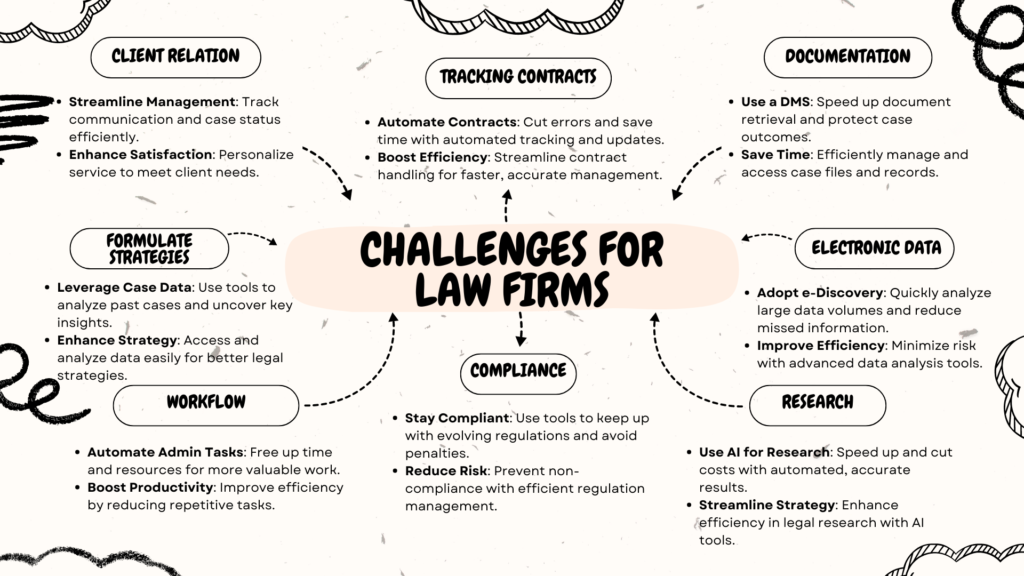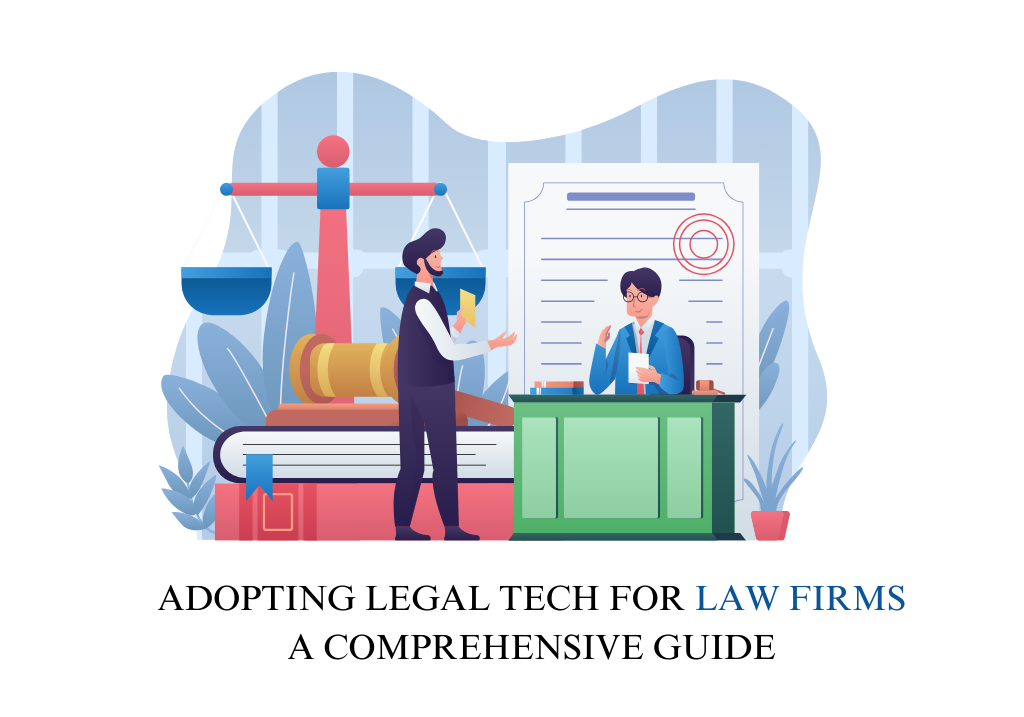Introduction
In an era where legal services are increasingly driven by efficiency, accuracy, and speed, law firms face the challenge of managing vast amounts of information, maintaining client relationships, and ensuring compliance with evolving regulations. Legal technology (“legal tech”) offers powerful tools that enable law firms to streamline their operations, enhance client service, and stay competitive in a dynamic market. This article explores the importance of legal tech for law firms, the challenges they face, a step-by-step guide to kickstarting the technology journey, and the best categories of tools to improve their operations.
Challenges Faced by Law Firms in Adopting Legal Tech
While the benefits of legal tech for law firms are clear, several challenges need to be addressed for successful adoption:

Kickstarting the Legal Tech Journey for Law Firms
To overcome challenges such as managing vast client relationships, handling complex contracts, and ensuring compliance with evolving regulations, law firms should adopt a structured, phased approach to integrating legal technology. Below is a detailed guide to help law firms strategically implement legal tech solutions in a way that maximizes impact, minimizes disruption, and ensures a smooth transition.
For law firms, the focus is on managing client relationships, handling complex contracts, ensuring compliance, and improving overall efficiency. The adoption of legal tech should be phased, starting with foundational tools and advancing to more specialized solutions.
| Phase | Key Activities | Specific Insights for Law Firms |
| Phase 1: Strategic Assessment and Planning | 1. Identify Pain Points: Conduct meetings with partners, associates, paralegals to identify key challenges (e.g., contract review delays, high administrative workloads).2. Map Out Legal Workflows: Document workflows for client intake, legal research, billing, etc., and identify bottlenecks.3. Set Measurable Goals: Aim to reduce contract review time by 40%, automate 70% of routine tasks, etc. | – Prioritize Contract Lifecycle Management (CLM): If contract handling is a significant issue, prioritize tools that automate and streamline contract processes.- Roadmap with CRM and DMS: Start with CRM for managing client relationships and Document Management Systems (DMS) for organizing legal documents. |
| Phase 2: Research, Evaluation, and Pilot Testing | 1. Evaluate Legal Tech Solutions: Look for tools that align with firm size, complexity of cases, and practice areas (e.g., AI-driven legal research for litigation-heavy firms).2. Engage Key Stakeholders in Demos: Conduct proof-of-concept trials with teams who will use the tools daily.3. Pilot Test in Departments: Start with high-impact departments (e.g., litigation teams for DMS, corporate teams for CLM). | – Focus on Integration Capabilities: Ensure solutions integrate seamlessly with existing systems (e.g., billing, case management).- Customization is Key: Work with vendors to tailor the solutions to specific practice areas and workflow needs. |
| Phase 3: Full-Scale Implementation and Change Management | 1. Develop Change Management Plans: Designate “tech champions” among lawyers and staff to drive adoption.2. Offer Comprehensive Training: Create training sessions tailored to different roles (e.g., paralegals vs. partners).3. Gradual Roll-Out: Start with departments most prepared or in need. | – Manage Resistance Effectively: Communicate benefits like improved client satisfaction, reduced workload, and faster turnaround times.- Ensure Secure Data Migration: Work closely with IT to avoid data loss. |
| Phase 4: Monitoring, Evaluation, and Continuous Improvement | 1. Monitor KPIs and Measure ROI: Track key metrics like user adoption rates, efficiency gains, and error reduction.2. Gather Regular Feedback: Conduct feedback sessions to refine tools and processes.3. Scale Up Gradually: Move to advanced tools like AI analytics, predictive modeling, and automated compliance. | – Conduct Regular Audits and Reviews: Ensure technology continues to align with firm goals and adapt strategies as needed.- Encourage Continuous Learning: Leverage industry webinars and legal tech forums. |
Phase 1: Strategic Assessment and Planning
- Conduct a Comprehensive Needs Assessment
- Identify Key Pain Points and Legal Challenges: Organize discussions with key stakeholders, including partners, associates, paralegals, and IT staff, to identify specific legal challenges. For example, if the firm struggles with contract management inefficiencies or delays in legal research, these areas should be prioritized for improvement.
- Map Out Current Legal Processes and Workflows: Document existing workflows for handling legal tasks such as client intake, contract drafting, legal research, and billing. Identify bottlenecks like repetitive administrative tasks or document retrieval delays that could benefit from automation. Mapping these processes will help identify where technology can provide the most value.
- Set Clear, Measurable Goals: Define specific objectives, such as reducing the time spent on contract review by 40%, automating 70% of administrative tasks, or improving document retrieval efficiency by 50%. Clear, measurable goals will guide technology selection and provide benchmarks for success.
- Develop a Strategic Legal Tech Roadmap
- Create a Phased Implementation Plan: Divide the technology adoption into manageable phases. Start with foundational tools like CRM systems for client management and Document Management Systems (DMS) for organizing legal documents. Once these are successfully integrated, progress to more advanced tools like AI-driven legal research and litigation management software.
- Prioritize Legal Tech Investments Based on Impact and Cost: Evaluate potential legal tech solutions based on their impact, ease of integration, scalability, and cost. For example, prioritize a Contract Lifecycle Management (CLM) system if contract handling is a significant challenge. This prioritization ensures that high-impact areas are addressed first.
- Set a Budget and Timeline for Implementation: Allocate a budget that covers technology acquisition, integration, training, and ongoing support. Establish a realistic timeline for each phase, allowing for piloting, feedback, and necessary adjustments to avoid disruptions.
Phase 2: Research, Evaluation, and Pilot Testing
- Research and Evaluate Potential Legal Tech Solutions
- Identify Cost-Effective and Scalable Legal Tech Tools: Focus on legal tech solutions that offer law firm-friendly pricing models, scalability, and ease of use. For example, consider cloud-based solutions that provide flexibility and can scale as the firm grows. Cloud-based systems often have lower upfront costs and reduced maintenance requirements, making them ideal for firms of all sizes.
- Request Demos and Conduct Proof-of-Concept Trials: Arrange product demonstrations and pilot trials to evaluate the technology in a real-world setting. Focus on solutions that are user-friendly, integrate well with existing workflows, and offer customizable features. For instance, testing a DMS in a litigation department allows firms to see how the technology performs in real case management scenarios.
- Engage Key Stakeholders in the Evaluation Process: Involve key team members—partners, associates, paralegals, and administrative staff—who will be the primary users of the technology. Gather feedback on usability, functionality, and fit within the existing ecosystem. This collaborative approach ensures buy-in from those who will use the tech daily.
- Pilot Test Selected Solutions in High-Impact Areas
- Select Pilot Projects for Each Technology: Choose specific departments or processes to pilot the technology. For example, test a DMS in litigation teams where managing large volumes of documents is a challenge or a CLM system in corporate law teams where contracts are frequently handled.
- Monitor Key Performance Indicators (KPIs) During the Pilot: Track KPIs such as time savings, error reduction, user satisfaction, and process efficiency during the pilot phase. Use this data to measure the effectiveness of the solution and identify areas for improvement.
- Customize Solutions Based on Feedback and Requirements: Work with tech vendors to customize the solutions to better fit the firm’s needs. This could include adjusting workflows, creating tailored templates, or setting up custom alerts for deadlines and key milestones.
Phase 3: Full-Scale Implementation & Change Management
- Implement Change Management and Training Programs
- Develop a Change Management Strategy: Address potential resistance to change by communicating the benefits of legal tech adoption to all team members. Highlight how technology will ease their workloads, improve efficiency, and enhance client satisfaction.
- Designate “Tech Champions” Among Team Members: Select tech-savvy individuals within each department to serve as “tech champions.” These individuals will help promote the adoption of new tools, provide peer support, and gather feedback on user experiences.
- Offer Comprehensive Training for All Teams: Create tailored training sessions for different roles within the firm. Provide ongoing learning opportunities such as webinars, advanced workshops, and e-learning modules to keep everyone up-to-date with the latest features and best practices.
- Roll Out Technology Solutions Across the Firm
- Expand Implementation Gradually: Roll out the technology solutions in phases, starting with the departments or processes most prepared or that have the most significant need for change. Gradual implementation allows for troubleshooting and adjustments as needed.
- Ensure Secure Data Migration and Integration: Work with IT experts to ensure that all relevant data from existing systems is securely transferred to the new platforms. Test the integration thoroughly to avoid data loss or operational disruptions.
Phase 4: Monitoring, Evaluation, and Continuous Improvement
- Monitor, Evaluate, and Optimize the Use of Legal Tech Solutions
- Track Key Metrics and Measure ROI: Continuously monitor performance metrics like time saved, user adoption rates, reduction in errors, and overall efficiency improvements. These metrics help assess the return on investment (ROI) and effectiveness of the technology.
- Gather User Feedback Regularly: Conduct regular feedback sessions with users to understand what is working well and where there might be room for improvement. Use this feedback to refine workflows, enhance user experience, and adjust training programs.
- Optimize and Scale Up: Based on feedback and data analysis, optimize existing processes and consider scaling up to more advanced tools such as AI-driven analytics, predictive modeling for case outcomes, or automated compliance monitoring systems.
- Conduct Regular Reviews and Stay Updated on Legal Tech Trends
- Encourage Continuous Learning and Improvement: Stay current with the latest developments in legal technology by attending industry webinars, participating in legal tech forums, and joining relevant professional communities. Encourage team members to share insights and suggest new tools that could enhance the practice.
- Schedule Regular Technology Audits and Strategy Reviews: Periodically review the performance of legal tech solutions and make necessary adjustments to align with evolving practice needs and goals. This ensures that the technology continues to provide value and supports the growth and sustainability of the firm.
Best Categories of Legal Tech for Law Firms
Based on the challenges and needs of law firms, the following legal tech categories are the most beneficial:
- Client Relationship Management (CRM) Systems
- Why It’s Useful: CRM systems help law firms manage client interactions, automate follow-ups, and provide personalized service, ensuring client satisfaction and loyalty.
- Key Features: Client communication tracking, automated follow-ups, contact management, and integration with other legal tools.
- Document Management Systems (DMS)
- Why It’s Useful: DMS allows for secure and efficient management of legal documents, providing features like full-text search, version control, and user access control, making it easier to find and track documents.
- Key Features: Document indexing, automated workflows, access control, audit trails, and integration with other systems.
- E-Billing and Invoicing Solutions
- Why It’s Useful: E-billing tools automate billing, invoicing, and payment processing, ensuring accuracy and transparency in financial transactions. They help manage legal spend and improve cash flow.
- Key Features: Automated invoicing, time tracking, billing rate management, expense tracking, and reporting.
- AI-Powered Legal Research Platforms
- Why It’s Useful: AI-driven legal research tools can significantly reduce the time spent finding relevant case law, statutes, and regulations. They provide quick insights and predictive analytics to support decision-making.
- Key Features: Natural language processing (NLP), citation analysis, case prediction analytics, customizable research dashboards, and integration with other legal tools.
- Litigation Analytics and E-Discovery Tools
- Why It’s Useful: Litigation analytics tools help law firms predict case outcomes, understand judge behavior, and analyze opposing counsel strategies. E-discovery tools automate the process of collecting, reviewing, and analyzing electronic evidence.
- Key Features: Predictive analytics, data visualization, automated evidence collection, secure data storage, and collaboration tools.
Conclusion
For law firms, adopting legal technology is essential to manage legal complexities, enhance client service, and improve operational efficiency. By strategically adopting legal tech tools, law firms can streamline processes, reduce costs, and deliver better outcomes for their clients. A structured approach—starting with a needs assessment and ending with continuous optimization—ensures that law firms can maximize the benefits of legal technology in a competitive legal market.


